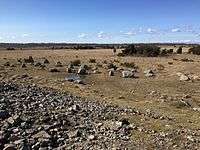Sandby borg
 Part of Sandby Borg's west wall. | |
| Location | Kalmar län, Öland, Konungariket Sverige (Sweden) |
|---|---|
| Coordinates | 56°33′09.6″N 16°38′23.2″E / 56.552667°N 16.639778°E |
| Type | Ringfort |
| History | |
| Founded | c. 480 A.D.[1] |
| Site notes | |
| Excavation dates | 2010-2011, 2013-2015 |
| Archaeologists | Dr. Helena Victor |
| Condition | Ruins |
| Website | SandbyBorg.se |
Sandby borg is a ringfort, one of at least 15 on the island of Öland, Sweden.[2]:17 It sits about 2 kilometers southeast of Södra Sandby village in Sandby parish in southeastern Öland. It is also close to the village of Gårdby.
From 2010 the fort has been subject of excavation that revealing that it was the site of a 5th Century AD massacre. The fort included 53 buildings, consisting of small, one-family houses in the middle and stables and storehouses closer to the walls.[2]
Location and size
Sandby Borg is only 42 meters from the shore line to a level spot about 2.5 meters above sea level on a low sand dike, low enough that at high tide the sea almost reaches the base of the fort's walls. The highest points of the wall are in the northeast at 3.1 meters above ground level, and in the southeast at 1.5 meters above ground level.
The fort is of oval shape, with the main axis oriented NW and SE. The length of the main axis is c.95 meters and the traverse is some 65 meters.[2]:25 The wall is about 4 meters thick, with the thickest part of the wall towards the northeast and the thinnest part towards the southeast.
Features
Two entrances pierce the walls, one in the north and one in the southeast. The fort had its own well.
West of the fort there is a structure that consists of several parallel rows of grey stone blocks.
Archaeological digging
Archaeologists from the museum of Kalmar County, Sweden, and Lund University started excavating the site in 2010, alerted by signs of exploratory digging by looters. There is a limited digging season and so far only a little of the fort and its dwellings have been excavated. Even so, there have been remarkable finds. Material finds consist of gilded silver and bronze buckles, and caches of beads and jewelry. What is more unusual is that ten skeletons have also been found, all in positions that suggest that the individuals involved were taken by surprise, killed, and left where they fell. Furthermore, it appears that the fort was not put to the torch but simply left with its dead strewn about, unburied.[2]:49, 52
The fact that there were children who were also killed leads Dr. Helena Victor of Kalmar Museum to speculate that these were indeed murders, rather than raiders, saying "Normally, raiders take the children with them [as captives].”[1] She does, however, also admit that they make assumptions sometimes based on evidence at the current dig site.[1][Note 1]
Archeologists have found a Roman gold solidus from the reign of Valentinian III (419-450 A.D.), that helps date the site. The archeologists excavating the site believe that the presence of the solidus is consistent with the fort's inhabitants being erstwhile mercenaries in the Roman army.[2]:37
The Sandby borg excavation team successfully raised funds via a Kickstarter campaign to complete the excavation of House #40, where several skeletons had been found. Their target was SEK 400,000, and they raised SEK 465,619 before the deadline of midnight 31 December 2014.[2]:13
Gallery
 Sandby Borg towards north-west. Marks of excavations seen in the middle.
Sandby Borg towards north-west. Marks of excavations seen in the middle. Shallow waters close to Sandby Borg.
Shallow waters close to Sandby Borg. Sandby Borg from inside in north-west direction.
Sandby Borg from inside in north-west direction. Outer entrenchment on the west side.
Outer entrenchment on the west side. Sandby Borg from inside in south-west direction.
Sandby Borg from inside in south-west direction.
Notes
- ↑ "We make these assumptions sometimes," she said.
References
- 1 2 3 Curry, Andrew (March 2016). "Öland, Sweden. Spring, A.D. 480". Archaeology Magazine. Vol. 69 no. 2. The Archaeological Institute of America. Retrieved March 5, 2016.
- 1 2 3 4 5 6 Söderström, Ulrika (2015). Sandby Borg: Unveiling the Sandby Borg Massacre (in Swedish). Kalmar lāns museum. ISBN 9789198236620.
Further reading
- History Blog: "Roman coin found in Sandby fort posthole" - accessed 30 November 2014.
- Meredith Bennet-Smith (October 12, 2013) "Mysterious Massacre Frozen In Time At 'Swedish Pompeii' Site" Huffington Post - accessed 30 November 2014.
- Kickstarter site for the project - accessed 30 November 2014
Coordinates: 56°33′09″N 16°38′21″E / 56.5526°N 16.6392°E